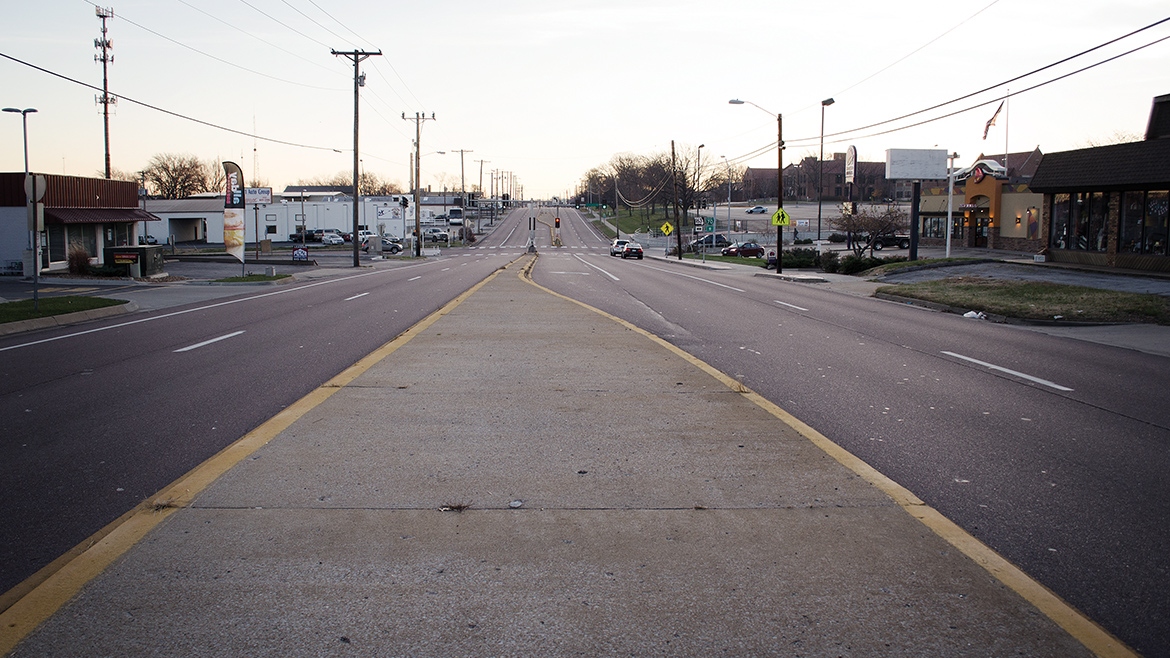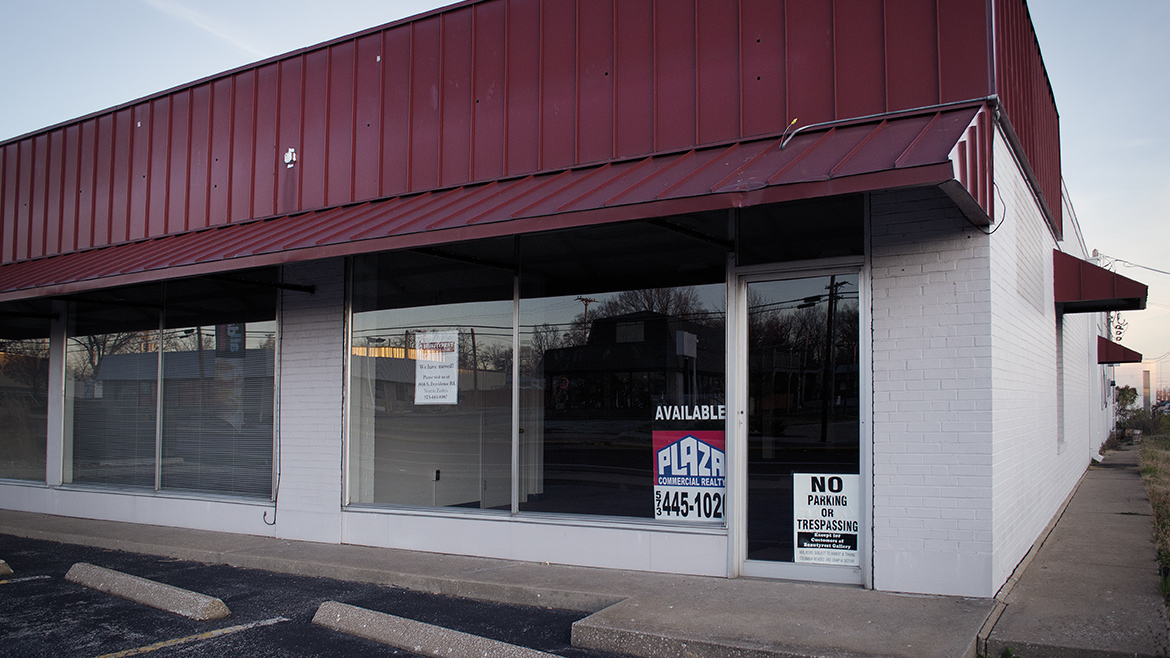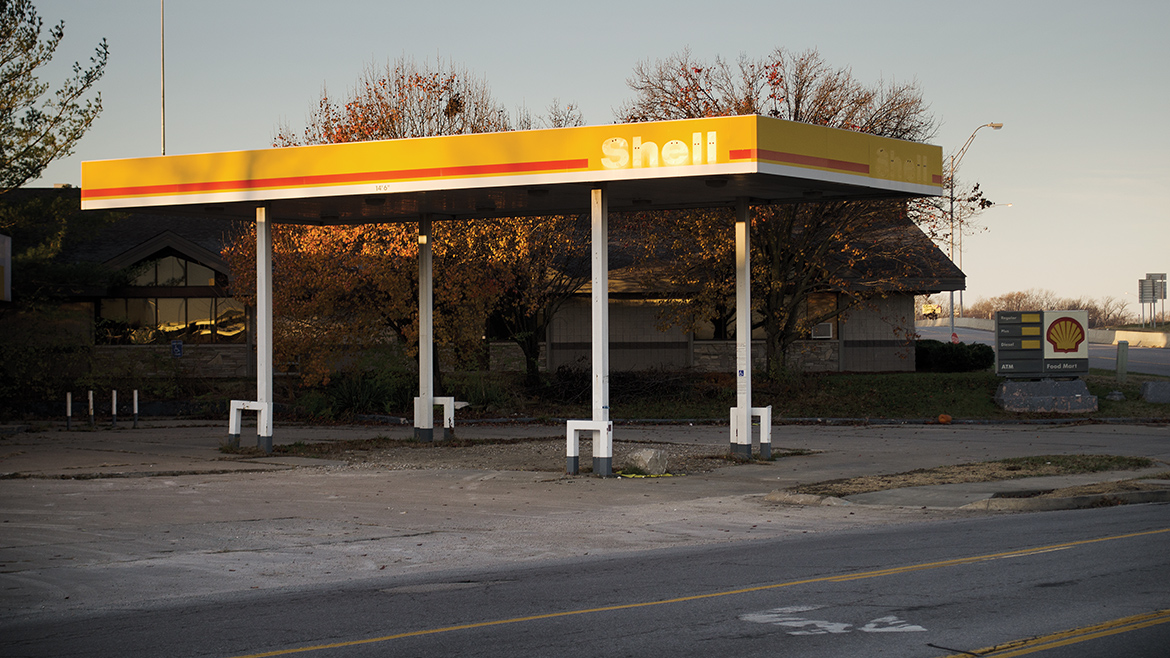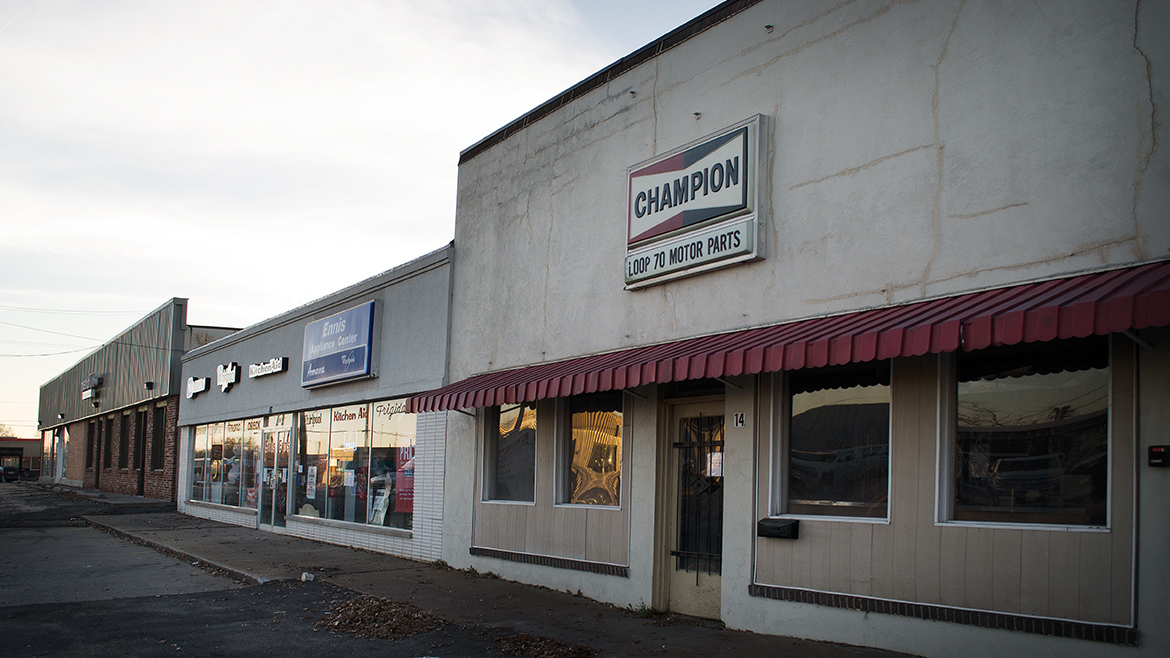Tempest in a Teapot

The Business Loop CID set out to improve a worn-down retail area. Instead, it created a national scandal. What’s next?
In 1949, the Griggs family moved from a home on West Broadway, in Columbia, out to the country. They bought a bigger piece of land and lived on the outskirts of town. Not that Columbia was so urban at the time — Dave Griggs, a toddler when his family moved, says his hometown was “a sleepy little burg back then.” The city’s population, roughly 30,000, was just beginning to bring in significant numbers of GI Bill enrollees at MU.
Life was still quiet in Boone County. During his childhood in the country, Dave would make routine trips back into town with his father. On weekends, they drove to Highway 40, the road now called Business Loop 70, to pick up cow feed at MFA. They would end the trip with breakfast, at a diner along the Loop called The Silver Griddle.
The Silver Griddle is now Tiger Town Treasures thrift shop, and Griggs now owns the building across the street: Dave Griggs’ Flooring America, a Business Loop tenant since 1975. It’s the same building where Griggs’ brother used to sell Chevys.
Griggs is now 69, with a distinguished career and a purposeful earnestness that has earned him a stout reputation in the business community. Throughout his tenure at Flooring America, Griggs has dabbled in the public eye: he’s currently the chairman of the Boone County Fire Protection District, and he’s also chaired the Chamber of Commerce and REDI, and he’s a former county commissioner.
Griggs is now an outspoken board member of the Business Loop Community Improvement District, a quasi-public entity created last spring to fund public space improvements on the maligned Loop, which would hopefully encourage investment. The project has been decades in the making for Griggs, who has watched the area slip from a well-trafficked, two-lane business hub to a crippled retail strip.
The Loop is now a four-lane road, with many storefronts up against traffic in such a way that redevelopment is difficult. The medians, a popular panhandling spot, are pocked with weeds and textured by cracked-off flakes of concrete. Some lots are empty; others have vacant buildings in disrepair; others are occupied by payday lenders, pawnshops and, in one building, a strip club. Griggs and other business owners have been working together for decades on ways to improve The Loop, and many of those owners have built successful businesses there. The Parkade, on the west end of the road, was Columbia’s first shopping mall, and now serves as a retail center, community college campus and office space for the CID.
Still, most of the Loop has been void of development for years, frozen in the past, untouched by the economic growth that’s changed the face of almost every other area in Columbia. “Because of lots of things,” Griggs says, “time has passed the Business Loop by.”
The CID is supposed to make up for lost time, but time costs money — money to spend on landscaping, infrastructure repair, business recruitment, and eventually hiring a consultant to draft a long-range corridor plan for the Loop. To make that money, the CID first levied a property assessment on businesses in the district, which earns the CID about $50,000 annually. But in the scope of what The Loop needs, $50,000 isn’t much, so the CID also wanted to levy a half-cent sales tax, which would normally be voted on by residents living within district boundaries, according to the state CID statute. But the Loop CID was arranged in such a way that it had no residents, which would leave the sales tax vote to property owners — if there had actually been no residents.
In August, the Boone County Clerk’s office discovered one registered voter living within the district. Under those circumstances, the one voter — 23-year-old college student Jen Henderson — would have had complete control over the sales tax vote. Local media picked up the story, followed by national publications, which accused the district of purposefully gerrymandering the borders to skirt a democratic vote. The national attention culminated in a segment on Comedy Central’s “The Daily Show,” which host Trevor Noah introduced with: “Voting is a sacred right. But is it?”
The story became somewhat less appealing to a national audience when local radio station KBIA identified 13 more voters in the district, but the damage to the CID’s reputation had largely been dealt by then. A headline from the Los Angeles Times went “A gerrymandering attempt that went hilariously awry.” A more blunt headline from The College Fix said “College student ruins secret plan to hike taxes on poor residents.”
Three characters emerged: Henderson, an outspoken critic of the proposed sales tax, the CID board, and CID director Carrie Gartner.

Gartner’s background is in politics. She managed campaigns and communications for various levels of state and local office before becoming director of The District, Columbia’s downtown corridor, in 2000. In that office, she presided over a downtown rebirth, culminating in a successfully formed CID, in 2011, which levied a property assessment and sales tax. After a brief stint with MU Health, Gartner was hired for a repeat performance, this time with The Loop. It’s been a different challenge.
“I don’t think there’s anyone in town who looks at the Business Loop and doesn’t say, ‘Yeah, that needs to be improved,’” Gartner says. In that sense, though, she considers herself lucky. The board insists that they have broad public support, at least at a core level, and they’re not without assets: Gartner touts the Loop’s DIY-ethic and base of “Saturday morning retail,” those shops that bring in customers working on a weekend project, like fixing a car or installing an appliance or planning a garden. Gartner and the board have a happy relationship, and the city has been supportive of the CID so far.
“The hard part is going to be ‘how do you undo 30 years of neglect?’” Gartner pauses. “Or, not neglect. It’s just that nothing has happened in 30 years.”
Part of the modernization included a new website and branding, designed with the help of local advertising firm Woodruff Sweitzer. The site’s home page is a collage of bright photos taken from around the Loop, some by Gartner herself. The tagline: “It’s good to be in The Loop.”
Gartner’s optimism may be The Loop’s most critical asset. In several interviews, Henderson accused Gartner of pressuring her to unregister, and she questioned the legitimacy of Gartner’s $70,000 salary (the board has repeatedly backed Gartner’s compensation, and her salary is unchanged in the CID budget.)
Gartner remembers her interaction with Henderson differently — she says they had a short, pleasant conversation about The Loop’s planned projects, and limited interaction after that — and criticisms lobbed at The Loop caught her off guard. The board began holding open meetings with nearby neighborhood associations, who were concerned about being intentionally cut out of the CID’s decision-making process. People asked why the board hadn’t been meeting with the public from the beginning.
“That’s the perception,” Board Chairman Tom May says. “But you can’t really do any of that process until you’re a formal entity.”
May directs public relations for MFA; he’s placid and deliberate in speech, and pragmatic about CID issues. Since gerrymandering accusations began flying, he’s dedicated personal effort to increasing community engagement. The board circulated a community survey asking users about what they’d like to see improved on The Loop. May knocked on potential tax voters’ doors to make sure they received the ballots in the mail. Those experiences have also been positive, which May expected.
“I’ve had to go and weed-out half the medians on Business Loop myself,” May said. “I haven’t talked to a single person that’s opposed to the Business Loop being improved.”

The community survey showed that Loop users were concerned with appearance and safety: The Loop and surrounding areas have developed a reputation for violent crime. May hopes that the CID’s improvements will encourage investment in the area, which would hopefully alleviate that problem.
May reached his most animated point when reflecting on media coverage of the CID’s alleged gerrymandering. “I think it’s just an embarrassment to the community,” he says of the national coverage. “Daily Show, L.A. Times, all they’re doing is making fun of our community, and we have a great community.”
The board’s response to the gerrymandering issue varies, but they all point out that the process for drawing the district was relatively simple: all land parcels with frontage on the Business Loop were included. Some were small; others, like the parcels with Mizzou North and Hickman High School, were big. The resulting district was funny looking, they say, but not particularly complex.
“I think I saw the gerrymandering thing in the Tribune the first time,” Gartner says. “And as soon as I saw it, I sent an email to [Tribune owner] Hank Waters and said, ‘This is not gerrymandering, and this is exactly how we drew the district’s borders.’”
Griggs is less discerning. “It’s obviously gerrymandering,” he says. “It was intentionally gerrymandered.” Before levying a sales tax, the CID knew they would first levy a property tax in the district, but wanted to do so only for business owners — not residents. So, before drawing the district, the board went to the county and asked if anyone lived in the properties fronting the Business Loop, and the county said no. “So,” Griggs says, “the plan was to gerrymander it — and frankly, that’s a fine term by me — to eliminate involving personal houses so we wouldn’t increase people’s taxes. So we’re criticized for that because people don’t really understand it. And I try to tell that story any chance I get.”
James Gordon and Kris Husted, reporters for KBIA radio, were trying to pitch their CID coverage to National Public Radio throughout the early fall. At that point, Henderson was still believed to be the sole voter in the district, and Husted and Gordon were looking for a way to distinguish their coverage of the story from other local media. They had an idea for an interactive map laying data of registered voters in Boone County over a map of the CID, which would hopefully illuminate how many voters lived near the border.
Gordon, who has a background in data journalism, drew the map up. To their surprise, 14 dots showed up inside the CID. Gordon and Husted thought they screwed up; Gordon ran the data again, with the same result. He called County Clerk Wendy Noren’s office. After talking for an hour, Noren and Gordon determined that there were 14 voters living in The Loop CID.
KBIA broke their story; NPR dropped them from consideration. Husted and Gordon figured people were more interested in the one-voter story.
“Who wouldn’t be?” Husted says. “It’s a perfect David and Goliath story. But if it’s too good to be true, it probably is.” He goes on, “The CID board was painted as villains initially, and that’s not really our job as reporters. We just present the facts and let people decide for themselves.”
KBIA’s discovery was welcome, though surprising, news for the board. May told me that he would prefer the vote be citywide — Columbia has a friendly record with sales tax increases — but that’s not the way the state ordinance is written.

The CID held its 14-person election on Dec. 10, and the sales tax passed, 4 to 3. $200 worth of groceries on the Business Loop will now cost $201. The board expects to bring in more than $200,000 with the sales tax annually. Some of that will go toward paying back legal debts involved with the CID’s creation, so planned projects still won’t have much capital to maneuver until later.
“Even with the sales tax, we won’t be a wealthy organization,” Gartner says. Her board members agree: it will take more money and more time to stop the inertia of a 30-year slide. “If we can do this in 20 years, then we’d really be brilliant,” Griggs says.
The short term has been more complicated than the long term. Gartner says that her job is less about politicking than it’s about convincing people of the CID’s mission. The sales tax fiasco made that more difficult.
“I think that whether they’re doing everything they can to engage with voters is sort of an open question,” Gordon says.
Husted nods. “It’s like the CID says, a half-cent sales tax really isn’t that much,” he says, pausing. “But it’s the principle. The principle has people up in arms.”
Gordon says The Loop has become a “tempest in a teapot.” The idiom traditionally means an exaggerated problem, but its literal interpretation seems apt too: a heavy storm in a tiny, pressurized space.
Still, The Loop is closer to improving now than it ever has been before. More local businesses may follow the lead of companies like True Media, which bought and renovated the old Commerce Bank building on The Loop in 2012. True Media’s CEO, Jack Miller, works closely with the CID board, and he seems to be equally as committed to improving the area through investment. In an email, Miller wrote that the area was ready for revival: “It’s strategically located with excellent access to the interstate,” Miller wrote. “The more I looked at the Business Loop, the more I became convinced that, with the right plan, the area could prosper again.”
Columbia is a different city now than it was in 1975, when Griggs started his business, and certainly different than it was when Griggs went to The Silver Griddle diner with his dad on Saturday mornings. But the CID board still thinks the road is significant, and they think that the public — eventually — will agree with them.
“It is the northern gateway to CoMo,” Griggs says. “And it certainly doesn’t look like the northern gateway should look, in my opinion.”
And it may stay that way for a while. Still, people will certainly be talking about The Loop.


